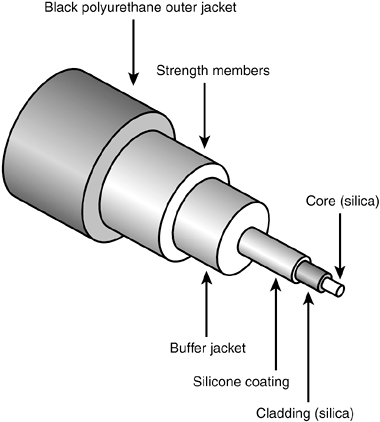Unfortunately, despite the advantages of fiber-based media over copper, it still does not enjoy the popularity of twisted-pair cabling. The moderately difficult installation and maintenance procedures of fiber often require skilled technicians with specialized tools. Furthermore, the cost of a fiber-based solution limits the number of organizations that can afford to implement it. Another sometimes hidden drawback of implementing a fiber solution is the cost of retrofitting existing network equipment. Fiber is incompatible with most electronic network equipment. This means that you have to purchase fiber-compatible network hardware.
Fiber-optic cable itself is composed of a core glass fiber surrounded by cladding. An insulated covering then surrounds both of these within an outer protective sheath. Figure 3 shows the composition of a fiber-optic cable.
Figure 3 Fiber-optic cable.
Two types of fiber-optic cable are available: single and multimode fiber. In multimode fiber, many beams of light travel through the cable bouncing off of the cable walls. This strategy actually weakens the signal, reducing the length and speed the data signal can travel. Single-mode fiber uses a single direct beam of light, thus allowing for greater distances and increased transfer speeds. Some of the common types of fiber-optic cable include the following:
-
62.5 micron core/125 micron cladding multimode
-
50 micron core/125 micron cladding multimode
-
8.3 micron core/125 micron cladding single mode
In the ever-increasing search for bandwidth that will keep pace with the demands of modern applications, fiber-optic cables are sure to play a key role.